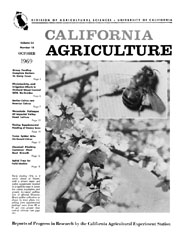All Issues

Cover:
Early feeding (2% to 3 weeks ahead of bloom) with a drivert sugar and pollen supplement resulted in a rapid increase in honey bee colony population, and greatly increased pollination of almond blossoms., Heavy pollen collections as shown in inset photo (resulting from supplemental feeding) were from 44 to 97 per cent greater than control colonies.
October 1969
Volume 23, Number 10
Volume 23, Number 10





